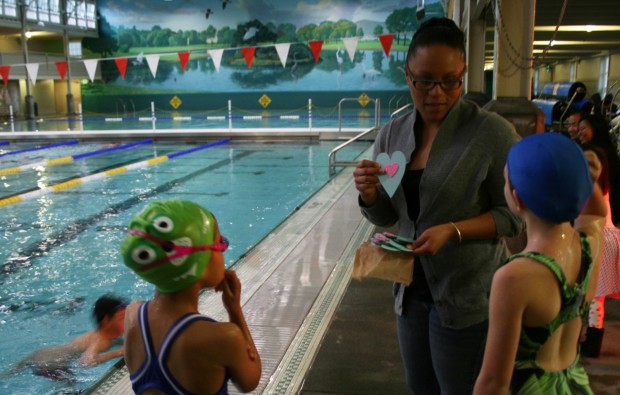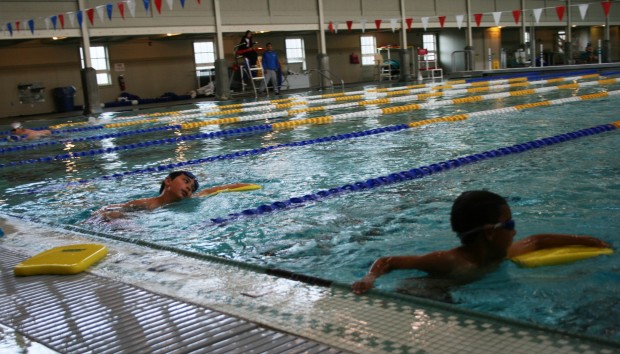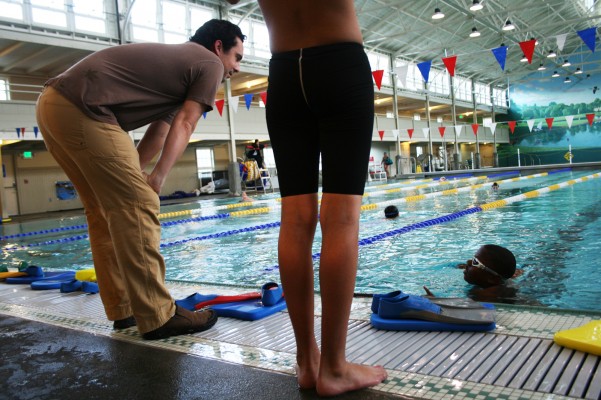| |
This is one of the payoffs for installing the bulkhead in the Plunge – a successful competitive swimming program that serves all youth in Richmond.
Tom Butt
http://richmondconfidential.org/2013/02/21/spawning-a-swimming-culture-in-richmond/
Spawning a swimming culture in Richmond



Assistant Coach Benicia Riveria handed out homemade Valentine's Day cards to the guppy swimmers after last week's practice. (Photo by: Jen Baires)
By Jennifer BairesPosted February 21, 2013 11:56 am
Ducking under the water, seven-year-old Colin twists his body around in a tight corkscrew, shoots his hands in front of his head and pushes off hard against the pool wall. His slight frame cuts through the water like an arrow in flight—graceful, precise, direct. And then the arrow goes awry: a few yards down his head pops up, his right arm readies for the first stroke and his right leg suddenly juts out of the water too. Like a periscope, his leg trails behind him, turning his skilled swimming stroke into a thrashing crawl.
One by one every kid on the swim team sets off in the same way, one small leg and foot barely visible over the waves they’re creating.
Benicia Riviera, the coach who’s ordered this “challenge drill,” laughs uproariously. She’s bent over, clutching her stomach as she watches the awkward trail of legs. Her laughter causes everyone not underwater to look around for its source.
“Nice one,” Coach John Schonder calls from across the pool, where he’s working with the older kids.
As each of Riviera’s swimmers returns to the safety of the shallow end they grab onto the side of the pool and raise their bright-red faces out of the water, gasping for breath through high-pitched giggles.
It’s toward the end of practice for the Richmond Sailfish swim team, and since it’s Valentine’s Day, most of the kids have eaten sugar shaped hearts and chocolate all day—at this point Riviera says she’s just trying to get them nice and tired, and amuse herself.
The last rays of sunlight stream in through the high windows in the cavernous Richmond Plunge, where the team practices every evening of the week. After a near decade-long closure, the Plunge re-opened two and a half years ago, but it’s one of only two community swimming pools in the city. None of the high schools in Richmond have a swim team. Part of that may be due to exposure, but it goes deeper than access to a pool. And while Riviera keeps an eye on the kids returning to the wall tired and happy, she keeps the other eye on the big picture: more kids, more adults, more pools – more people who find swimming across the pool with one leg in the air as rewarding and amusing as she does.
Riviera is the assistant coach of the Richmond Sailfish team. Head coach John Schonder brought her on a little over a year ago. Together the two coaches, and a dedicated board of directors, are working to grow the “swimming culture” in Richmond, to reach more kids and adults (they also run an adult masters team) and teach them first how to swim and then, hopefully, to love it.
“It’s a lot about exposure,” Riviera says. Swimming, she adds, is not a sport that many kids in Richmond consider, and that’s what they want to change.
According to a recent study commissioned by USA Swimming (the governing body for swim teams in the United States), nearly 70 percent of African American children and 58 percent of Hispanic children have little to no swimming abilities—putting them, the study concluded, at a much higher risk of drowning. The study also found that often the reason parents don’t take their kids to swimming lessons is because of the parents’ fear of water.
Most swim teams expect kids to be able to swim before they can be on the team. But, in Richmond, Schonder soon found that he’d have to approach things a little differently.
“We started last summer doing swim lesson programs,” said Schonder. They also reached out to schools—elementary through high school—in the area to work with after-school programs and organize swimming lessons.
“The first year we stayed in the shallow end just teaching them how to swim,” said Schonder.
It’s a year-round swim team, so the numbers fluctuate, but now—going into the third year as a team—Schonder says the team boasts an average of 65 swimmers. Half of them are Hispanic/Latino, 25 percent are Asian, 10 percent are African American—and every one of them can make it across the 25-yard pool multiple times.
“I’m really kind of impressed by it,” says Erin Conklin of Richmond while she watches her seven-year-old son zip back and forth across the pool during practice.
She brought her boy to the Plunge last summer for swimming lessons while the team held practice in the deeper end of the pool. “After his lessons, he walked straight up to Coach John and asked to be on the team,” Conklin said.
Schonder said he intentionally held practices at times when he knew the Plunge staff would be holding swimming lessons. He hoped that kids in the lessons would see the kids on the team having fun and ask to join.
Helen Gee, from Albany, said that’s how her two kids ended up on the team, too. She heard about the Plunge and its swimming lessons from a friend and decided to sign up her kids. After watching Schonder and Riviera working with the team on the other end of the pool, and seeing how much her kids enjoyed the lessons, she asked Schonder if they could be on the team.
In high school, Gee said she nearly drowned in a pool and has avoided swimming ever since. But she didn’t want the same for her children. “After that experience I decided if I ever had kids they were going to know how to swim,” she says.
Every practice—which happen at 4 p.m. every day of the week—Gee and her husband sit quietly on a poolside bench and watch their kids swim.
“It’s relaxing after a long day at work,” Gee says, smiling as she glances at her daughter’s bright green frog cap bobbing above the water.
Swimming is an expensive sport, both for those hoping to start a successful program and for the families of swimmers.
For a family with one beginner level swimmer—Guppy—on the team for a year it’s $600. Payments are spread out throughout the year—January, April, July and October—and it’s not mandatory that everyone swim year-round. The cost for a single swimmer goes up depending upon their skill level (stronger swimmers have longer practices), but there are small breaks for parents with more than one swimmer on the team.
To help with the cost, Schonder and the organization that oversees the swim teams—Richmond Swims—spend a lot of time fundraising. They offer full and partial scholarships.
Qualification for a scholarship, Schonder says, is similar to the free or reduced lunch programs in schools. About a quarter of the team is on scholarship.
“We didn’t want to be so exclusive,” Schonder said, “We wanted to make our programs available to everyone in the community.”
To maintain the scholarships the team hopes to raise $10,000 a year from local business and various grants.
They’re also raising money to purchase a couple more starting blocks for the pool. Right now there are only two. For the team to hold swim meets at the Plunge they’ll need a complete set. Swim meets – and the money they could raise by selling snacks there – would help further grow the program, Schonder says.
“It’d be great to bring swim meets here,” he said, “It’s something that may be a first in city history.”
Long term, Schonder says he hopes to partner with high schools in the city and create a competitive unified swim team. “I’d love every year to be graduating kids out of high school and into colleges,” he said. “Possibly with scholarships for swimming, or even academics.”
The benefits of swimming, Schonder says, extend past the pool. “It builds positive character, good work ethics…and swimmers usually have higher GPAs than athletes in other sports,” he said.
Right now, the oldest kid on the team is 15. He’s new to the sport, but like the others he’s learning fast.
“We have kids that when they started they couldn’t swim,” Schonder said, “and are now achieving time standards” — USA Swimming defined time goals that are set depending on distance, type of stroke and age of swimmer.
Schonder and Riveria split the team into the stronger—and usually older swimmers—and the younger, less adept guppies. Riveria coaches the younger ones and Schonder takes the more advanced swimmers.
When they coach, their difference in temperament and style stand out. Riveria yells over the kids, jokes and dances around while she gives instruction—usually acting out the stroke for the kids—and is rarely without a smile and laugh.
Schonder speaks more softly. He instructs his kids with a few well-timed words of encouragement—“get ready to go on the ten”—but he is quick to smile and help if any of the kids struggle.
At the end of the Valentine’s Day practice Schonder has his kids get out of the pool and gather around for push-ups. A few groan and grumble—they’ve been swimming for about two hours—but eventually they all get down in the proper position and start counting off.
Riveria calls her kids out of the water for a special Valentine’s Day surprise, too. They line up in front of her and one by one she hands them homemade, heart-shaped paper Valentine’s Day cards.
“Watching a kid complete the full stroke for the first time is like watching my own walk for the first time,” Riveria says. “I’ll yell at John, ‘John! John! Look!’”
“Yeah, we get pretty excited,” Schonder says smiling. “Swim coaches do it because they love it, not for anything more.”
A few of the kids linger behind in the water after practice, splashing around, diving down to touch the bottom of the pool and slithering under the lane lines. They’ve been swimming for over two hours and their fingers and toes have turned to prunes, but they still don’t want to get out.
|
|

